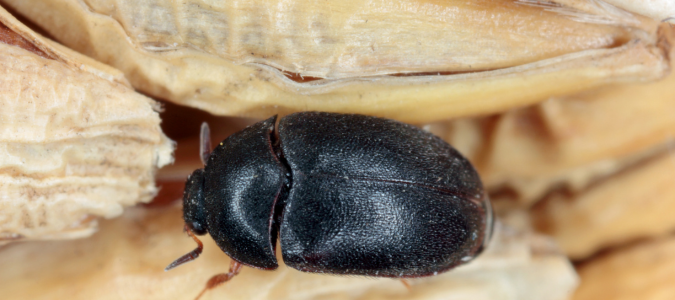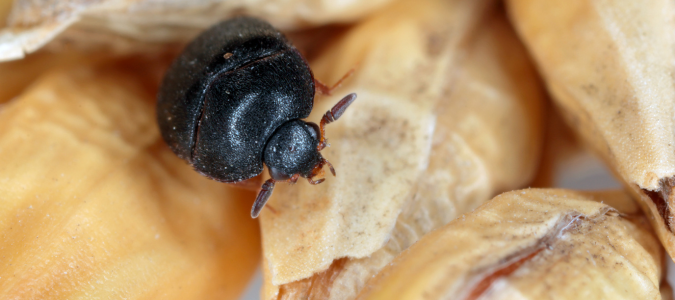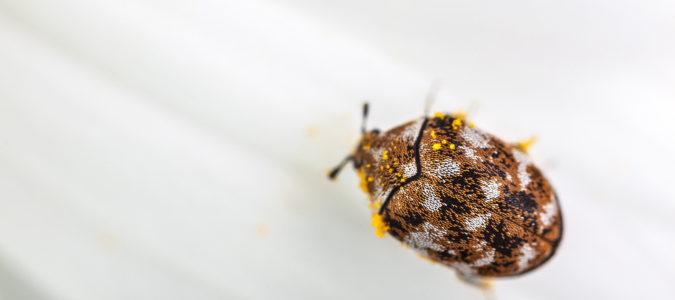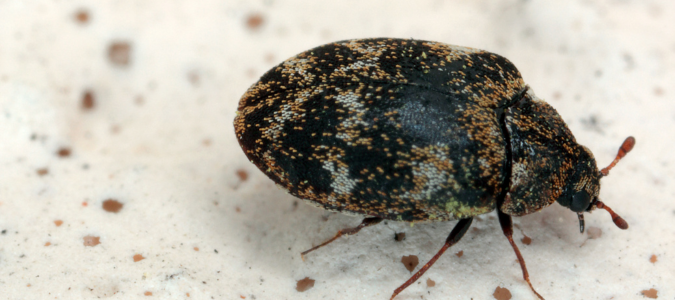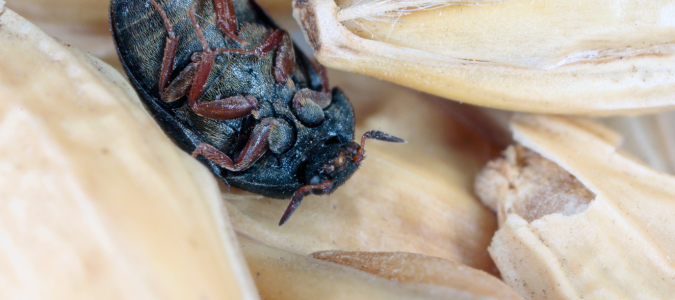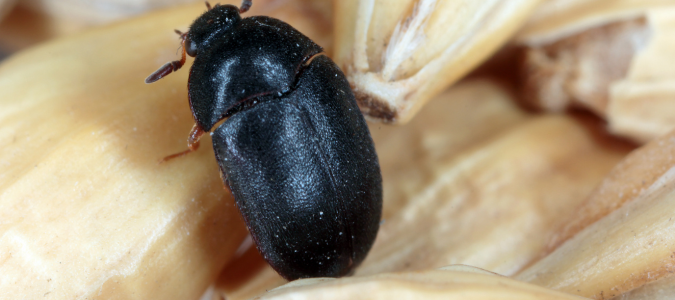Carpet beetles are destructive pests that no homeowners want to deal with. The first step in getting rid of carpet beetles, often called carpet bugs, is identifying and understanding the various species.
Next, it’s important to catch the signs of a carpet beetle infestation, such as holes or thinning areas of your carpets and rugs. Keep in mind that these pests infest all types of natural fibers.
Finally, keep reading to learn a few do-it-yourself methods that can help reduce a carpet beetle infestation. Since these pests reproduce rapidly, it’s best to use a professional pest control service to fully control the problem before more damage is done.
How To Identify Different Types of Carpet Beetles
Carpet beetles are small beetles that like to infest carpets to lay their eggs. While they are most commonly found in carpets, these pests will also infest wool, leather, felt and silk.
These fibrous materials make perfect places for carpet beetles to lay their eggs. The material offers protection, and once the eggs hatch into carpet beetle larvae, they feed off of the carpet or fabric.
Most homeowners discover a carpet beetle infestation by identifying carpet beetle adults. Adult carpet beetles are tiny pests that are typically 1/10 inch in length. Their bodies are shaped like elongated ovals, usually dark brown or black. However, carpet beetle color may vary by species.
All species of adult carpet beetle have hard outer casings that hide a pair of wings. Keep reading for more information on the various types of carpet beetles.
Common Carpet Beetle
The common carpet beetle is the most common type of carpet beetle. In the larvae stage, these beetles are known as “woolly bears” because of their fuzzy appearance. Common carpet beetle larvae feed on carpets, clothing, upholstery, pet hair and any other natural fibers they can find. Adult common carpet beetles are covered in colorful scales.
Varied Carpet Beetle
Varied carpet beetles are also known for being destructive in their larvae state. Once these pests reach adulthood, they prefer to feed on nectar and pollen. However, the larvae enjoy a diet based on various materials, such as fur, feathers, carpet and rugs. If they have access, varied carpet beetle larvae will feed on any stored food in your home.
Unlike the common carpet beetle with their fuzzy outer layer, varied carpet beetles are known for their dense and bristly hairs. Once these beetles reach adulthood, they develop distinctive white, yellow and brown scales on their wings. Adult varied carpet beetles are known for being slightly smaller than common carpet beetles.
Furniture Carpet Beetles
Furniture carpet beetles get their name because they prefer to infest pieces of furniture. They gravitate towards upholstered furniture, especially if it’s made with natural fibers. However, they don’t only feed on furniture. These pests prefer to feed on carpets, clothing and common household items.
Adult furniture carpet beetles have brown or black bodies and a unique pattern of yellow scales. They typically measure around 1/12 to 1/8 inch long. Furniture carpet beetles in the larvae state look extremely similar to common carpet beetle larvae.
Enlist Professional Help to Get Rid of Carpet Beetles
Since carpet beetles are such small pests, it can be hard to tell the species apart. The best thing to do when you notice a carpet beetle infestation is to contact a professional pest control service. An expert can control the infestation so you can feel comfortable in your home again.
Top Signs of a Carpet Beetle Infestation In the Home
It’s important to educate yourself about the signs of a carpet beetle infestation. The earlier you spot an infestation, the easier it is to banish these pests.
The most common sign of a carpet beetle infestation is spotting holes in your fabrics. This could include your rugs, clothing, upholstered furniture, curtains, carpets and more. They particularly like to feed on natural fibers such as wool, silk, felt, fur and feathers.
These pests prefer wool over other fabrics, so it’s important to check for holes in your wool rugs, blankets, clothing and any other wool items. Along with holes in your fabrics, you may also notice rips and frayed edges.
Next, thinning rugs or carpet is another common sign of a carpet beetle infestation. If you notice a threadbare spot on your carpet or rug that wasn’t there before, it could be because carpet beetle larvae are eating away at the fibers. Pay special attention to areas with low foot traffic because carpet beetles tend to infest areas where they won’t be disturbed very much.
The third most common sign of a carpet beetle infestation is seeing the shed skins of the carpet beetle larvae. These pests shed their skins several times as they grow through their life stages, so you may see them on your carpet.
Carpet beetles’ discarded larvae skins look like poppy seeds or tiny grains of sand. They are a brownish color. It’s most common to find the skins in discreet areas, such as hidden corners, inside closets or underneath furniture. If you find carpet beetle skins, there is no doubt that a carpet beetle infestation is nearby.
The Carpet Beetle Lifecycle
Along with understanding the signs of carpet beetles, it’s important to know about the carpet beetle lifecycle to help you catch an infestation. The carpet beetle lifecycle includes four stages: egg, larva, pupa and adult.
Carpet beetle eggs are typically laid on carpets or other fabrics that serve as a food source. They are tiny white eggs that hatch within one to three weeks after laying.
Once hatched, carpet beetles go through the larva stage, which is when they are the most destructive. In order to grow rapidly, they feed on natural fibers nonstop. Since the larva stage last for several months, they can cause more damage if they are not discovered. Carpet beetle larvae are small and hairy and range from light brown to black in color.
Next, carpet beetles go through the pupa stage, which takes place inside a cocoon-like structure. During this stage, they go through a metamorphosis in order to become carpet beetle adults. The pupa stage can last anywhere between a few weeks to a few months depending on environmental factors.
Finally, carpet beetles emerge from their cocoons as adults. In this stage, carpet beetles prefer to feed on pollen and nectar. However, that does not mean that the destruction is over. Adult carpet beetles lay eggs and start the entire lifecycle over again.
Adult carpet beetles typically live for four to eight weeks, and females usually lay eggs three times in their lives. Each hatch can have anywhere between 20 and 100 eggs in it.
Since carpet beetles reproduce so rapidly, they can quickly become a big problem in your home. It’s smart to contact a pest control professional to control a carpet beetle infestation.
How to Get Rid of Carpet Beetles
There are several do-it-yourself methods that homeowners can use to help control and deter carpet beetles. First, it’s important to vacuum regularly to reduce the population. Pay close attention to baseboards, windowsills, doors and furniture with crevices. Make sure you empty the vacuum bag outside so that the carpet beetles cannot come back to your home.
Next, decluttering your home and keeping it dust-free can help reduce a carpet beetle infestation. These pests thrive in dusty areas that offer plenty of places to hide, which means that a clean home is a less hospitable place for them to lay eggs.
Washing and drying your fabric items on high heat can also help treat carpet beetle larvae and adults. On the flip side, extreme cold can also control carpet beetles. Placing some of your items in the freezer can help get rid of these pests. You should also routinely wipe down your surfaces with a damp cloth to remove any carpet beetle eggs or larvae.
While these at-home methods can help reduce a carpet beetle infestation, they are not proven to control the population completely. For the best results, it’s best to contact a pest control specialist. They will have the expert tools and knowledge to control the population.
Contact the Experts to Get Rid of Carpet Beetles
Carpet beetles are unwelcome house guests that can become extremely annoying for homeowners. They are known for destroying carpets and rugs; however, they feed on all kinds of natural fibers.
The signs of a carpet beetle infestation include holes in your carpet, thinning rugs and discarded larvae skins.
For the most effective approach, contact an expert to control any carpet beetles in your home. A professional pest control service can kick them out before they have a chance to do more damage.
ABC Can Treat for Carpet Beetles
Instead of battling carpet beetles on your own, contact ABC Home & Commercial Services. Our professionals can develop an effective pest treatment plan, so you can feel comfortable in your home again. They can also help treat other pests you may find in your house, like cockroaches and beetles.
